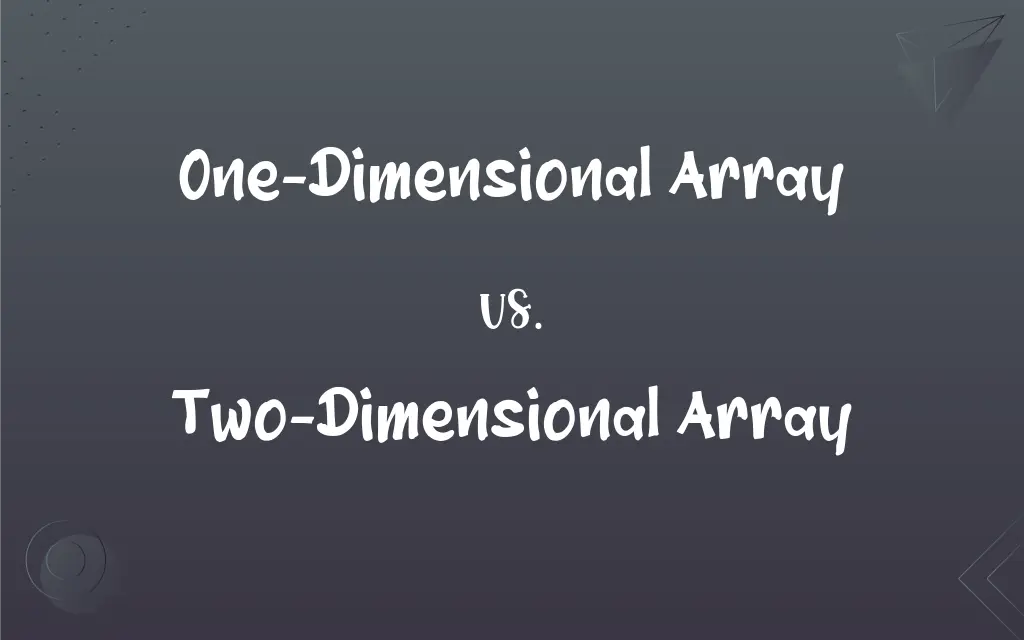One-Dimensional Array vs. Two-Dimensional Array: What's the Difference?
Edited by Aimie Carlson || By Janet White || Published on February 14, 2024
A one-dimensional array is a linear data structure storing elements in a single row or column, whereas a two-dimensional array is a tabular data structure with rows and columns.

Key Differences
A one-dimensional array is a fundamental data structure that stores elements in a linear sequence, each accessible by a single index. In contrast, a two-dimensional array extends this concept by organizing data in a grid-like structure, requiring two indices to access individual elements – one for the row and another for the column. Both types of arrays are used to store collections of data, but their structural differences dictate their respective applications.
In a one-dimensional array, elements are stored in a contiguous block of memory, with each element directly succeeding the previous one. This simplicity allows for efficient access and manipulation of data. On the other hand, a two-dimensional array, essentially an array of arrays, provides a more complex structure that is ideal for scenarios where data is naturally organized in a tabular format, such as matrices or spreadsheets.
The memory allocation of a one-dimensional array is straightforward and linear, often leading to better memory utilization and performance in linear data processing. In contrast, the memory allocation for a two-dimensional array is more complex, as it involves allocating memory for a series of arrays, potentially leading to higher memory consumption and a need for more complex memory management.
When it comes to ease of implementation, one-dimensional arrays are typically simpler and more straightforward to use and understand, making them a good choice for beginners or for applications requiring simple data storage. Conversely, two-dimensional arrays, with their added complexity, are more suited for advanced applications that require the organization of data in a grid-like format, such as in simulations or complex data processing tasks.
The choice between a one-dimensional array and a two-dimensional array often comes down to the specific requirements of the application. One-dimensional arrays are ideal for scenarios where data can be represented in a single line, like a list of names. In contrast, two-dimensional arrays are the go-to choice for representing more complex data structures like game boards or pixel grids in graphics.
ADVERTISEMENT
Comparison Chart
Structure
Linear, single line of elements.
Tabular, grid of elements with rows and columns.
Indexing
Single index to access elements.
Two indices (row and column) needed.
Memory Allocation
Contiguous, linear memory usage.
More complex, potentially higher memory use.
Ease of Use
Simpler and more straightforward.
More complex, suitable for advanced applications.
Ideal Use Cases
Simple data lists and sequences.
Complex data grids like matrices or spreadsheets.
ADVERTISEMENT
One-Dimensional Array and Two-Dimensional Array Definitions
One-Dimensional Array
A one-dimensional array is a collection of elements in a single line.
The array [1, 2, 3, 4] represents a one-dimensional array of integers.
Two-Dimensional Array
A two-dimensional array is a grid of elements accessed by two indices.
The 3x3 array [[1, 2, 3], [4, 5, 6], [7, 8, 9]] uses two indices for element access.
One-Dimensional Array
It is a series of elements of the same type placed in a row.
The array [100, 200, 300] contains elements of type integer in a row.
Two-Dimensional Array
A two-dimensional array is a matrix-like structure with rows and columns.
The array [[1, 2], [3, 4]] represents a 2x2 two-dimensional array.
One-Dimensional Array
Represents a basic form of array storing elements linearly.
In the one-dimensional array [5, 10, 15], each element is a multiple of 5.
Two-Dimensional Array
It's a collection of elements organized in rows and columns.
In the two-dimensional array [[‘red’, ‘blue’], [‘green’, ‘yellow’]], blue is in the first row, second column.
One-Dimensional Array
It's a linear data structure with elements accessible by a single index.
In the array ['a', 'b', 'c'], b is accessed using index 1.
Two-Dimensional Array
It's an array of one-dimensional arrays, forming a table.
The two-dimensional array [['John', 'Doe'], ['Jane', 'Doe']] is like a table with two rows and two columns.
One-Dimensional Array
A one-dimensional array is a contiguous block of elements.
The array ['apple', 'banana', 'cherry'] stores its elements in contiguous memory locations.
Two-Dimensional Array
Represents a complex structure for multidimensional data storage.
In the array [[0, 1], [2, 3], [4, 5]], each row can represent a coordinate pair.
FAQs
How are elements accessed in a two-dimensional array?
Using two indices, one for the row and one for the column.
Can one-dimensional arrays store different data types?
Typically, they store elements of the same data type.
Is memory allocation different for these arrays?
Yes, one-dimensional arrays use linear memory, while two-dimensional arrays may have more complex allocation.
What is a two-dimensional array?
A tabular data structure with elements organized in rows and columns.
What is a one-dimensional array?
A linear structure storing a sequence of elements in a single row or column.
How do you initialize a two-dimensional array?
By specifying the size for rows and columns and optionally the elements.
How are elements accessed in a one-dimensional array?
Using a single index corresponding to the element's position.
Can two-dimensional arrays have varying row lengths?
Yes, though it's more common for rows to have uniform lengths.
What are common uses for one-dimensional arrays?
Storing simple lists of data like numbers or strings.
Can one-dimensional arrays be converted to two-dimensional?
Yes, by grouping elements into arrays within an array.
Are one-dimensional arrays more memory-efficient?
Often, yes, due to their simpler, linear memory allocation.
Can two-dimensional arrays be multidimensional?
Two-dimensional arrays are a form of multidimensional arrays.
What are common uses for two-dimensional arrays?
Representing matrices, grids, and tabular data.
Are there size limitations for these arrays?
Yes, depending on the programming language and available memory.
How do you initialize a one-dimensional array?
By specifying the size and optionally the elements.
Can two-dimensional arrays be visualized as tables?
Yes, they naturally represent data in a tabular format.
Is iteration over a one-dimensional array simpler?
Generally, yes, due to its linear structure.
How do you iterate over a two-dimensional array?
Typically using nested loops, one for rows and one for columns.
Are dynamic operations easier in one-dimensional arrays?
Generally, yes, as they have a simpler structure compared to two-dimensional arrays.
Do programming languages treat these arrays differently?
Yes, implementation and syntax can vary between languages.
About Author
Written by
Janet WhiteJanet White has been an esteemed writer and blogger for Difference Wiki. Holding a Master's degree in Science and Medical Journalism from the prestigious Boston University, she has consistently demonstrated her expertise and passion for her field. When she's not immersed in her work, Janet relishes her time exercising, delving into a good book, and cherishing moments with friends and family.
Edited by
Aimie CarlsonAimie Carlson, holding a master's degree in English literature, is a fervent English language enthusiast. She lends her writing talents to Difference Wiki, a prominent website that specializes in comparisons, offering readers insightful analyses that both captivate and inform.







































































